The film changing how we see the internet - BBC News
When we think about how the internet shapes our lives, especially in art, we tend to imagine the worst. From TV shows like Black Mirror and feature documentaries like The Social Dilemma, to novels like The Circle, writers and filmmakers have portrayed the digital realm as one where we indulge self-destructive and narcissistic impulses, and where our privacy and security is breached. However, as the dystopian treatments of the internet mount up, one filmmaker has been on a different mission: to showcase the beauty of online connection. In the eyes of Japanese anime director Mamoru Hosoda, the web is an ever-evolving realm of exciting potential, an attitude embodied in his aesthetic approach to visualising this digital world.
More like this:
– How The Matrix became a reality
– 22 films to watch in 2022
– The animation that showed me the meaning of life
Hosoda's optimism about our interactions with the digital world are most apparent in his latest feature Belle, which is released in the US this week. A remix of Beauty and the Beast for the digital age, it tells the story of Suzu, a teenage girl living in the Japanese countryside with her widowed father, from whom she is partly estranged because of his lingering grief, and his unspoken lack of understanding as to his child's state of mind.
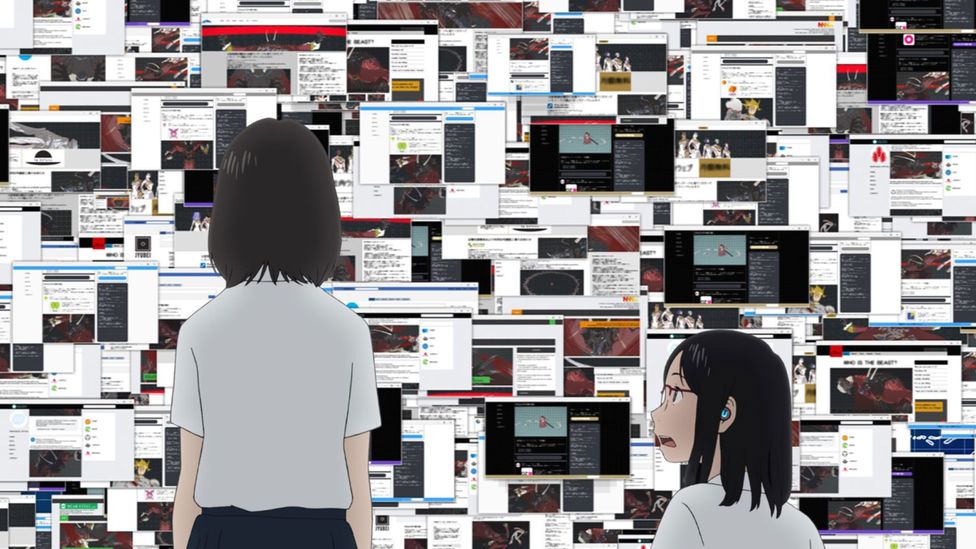
A 21st Century update of Beauty and the Beast, Belle centres on Suzu, a teenager with a parallel online existence as digital popstar Bell (Credit: Studio Chizu)
As it turns out, Suzu is spending her time as a popstar in the parallel world of "U", a virtual reality that promises a new beginning and a fresh start, something extremely promising for a teenager uncomfortable in her own skin. As the internet popstar Bell (to be clear, spelt without an "e" as in the title, as Suzu's name translates to "Bell" in English) she finds immediate viral fame, something that quickly brings her into contact with another famous – or rather, infamous – denizen of U: "The Beast", with whom Suzu feels a mysterious kinship.
In some ways, Belle could be seen as riffing on our increasing desire to occupy fully-visualised virtual social spaces – as seen for example, with games like Fortnite and Animal Crossing: New Horizons, acting as areas for concerts or interviews, and allowing people the ability to mingle during lockdown. But it's also much more fundamentally about the whole nature of online communication, and the way it can facilitate both personal transformation and self-reflection.
"I think the fact that there is this other world where we can be another version of ourselves [helps to show] that we are not just what we show to society," Hosoda tells BBC Culture. "Belle and Suzu are so different that they're virtually different people, but they're actually the same person. Sometimes we end up believing that we are only that one side of ourselves, but actually we have many dimensions. And learning that and believing that helps us to be more free."
Hosoda's fantasies of digital living
Hosoda's directorial career began around the turn of the millennium, and as his filmography has grown, parenthood and the lives of children have clearly become his pet themes. His previous film, 2018's Mirai, explores a father becoming a stay-at-home parent for the first time. Before that, 2015's Wolf Children and 2012's The Boy and the Beast both see single parents fear over where their children's independence will lead them, as well as just how much influence they hold over the shape of their lives. But alongside this focus on the family, a more specific interest he has repeatedly explored has been the role that the internet plays in the development of modern-day children – it's something he first touched upon in his very first feature film, 2000's Digimon: The Movie and has returned to in 2009's Summer Wars, about a high-school student getting involved in an online world called Oz, and now Belle.
Indeed this motif of children seeking guidance and refuge in fantastical digital realms is perhaps the most striking element of his work – even in his films that don't explicitly deal with the internet like Mirai, where the young protagonist's family tree is presented as a sort of traversable web space. His films often visually reflect the influence of digital culture by having one foot in and one foot out of reality – for example, while his characters may be designed with a subdued and natural look, they very often act with outsized, cartoonish reactions. Thematically, the mundane typically clashes with the otherworldly as his young or adolescent protagonists navigate their rapidly changing lives by doing something physically impossible – time travel in The Girl Who Leapt Through Time and Mirai, being spirited away to another dimension in The Boy and the Beast, and entering a virtual reality in Summer Wars and Belle.
Belle is both an encapsulation of the themes and aesthetic of Hosoda's filmography up to this point and a bold evolution of them. This is especially true of the film's lavish animation production, which mixes traditionally drawn 2D imagery with more 3D computer animation than any of Hosoda's previous work to reflect the film's parallel realms: 2D is used for the real world, and 3D for the digital sphere, with the former's intentional flatness contrasted with the latter's sense of expansiveness, created through broad, sweeping movements of the virtual camera. Suzu's life literally appears narrow, until her life as Bell opens it up to new dimensions, the world seeming impossibly large during her performances. This divide further emphasises Hosoda's vision of the internet as a social space that enables reinvention: when Suzu becomes Bell, she becomes a figure that is physically impossible in the 2D space of her world,.
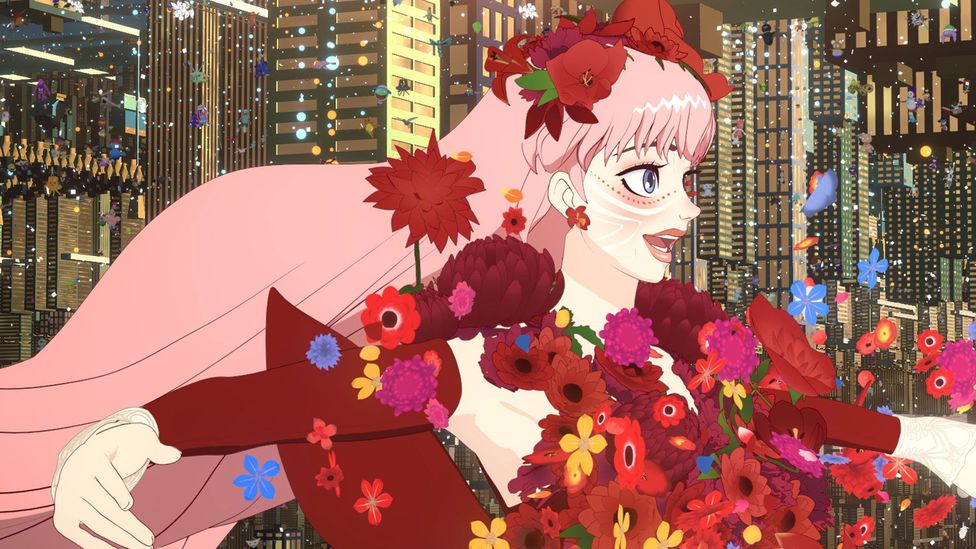
The beauty of the film's virtual world "U" is established with Bell's first appearance in a gown made of live roses (Credit: Studio Chizu)
The generally bright, optimistic view that Hosoda's films take towards the virtual space immediately makes him stand apart from his contemporaries. Many landmark anime films concerning the internet have viewed it as pathological, whether in encouraging possessive parasocial relationships and fake identities, or enabling new ways for ruling bodies to be invasive. One such film is Satoshi Kon's 1997 anime Perfect Blue, where the newfound intimacy that the internet provides with strangers is seen as disturbing and destabilising; its pop-singer-turned-actress protagonist Mima is stalked by obsessive fans and discovers a website set up by someone pretending to be her. As Mima loses grip on reality Kon's use of subjective perspective, immersing us in the protagonist's point of view, leads us to mistrust the very images that we witness, in a manner that evoked the internet's potential as vehicle for fabrication, where our online personas become malleable constructs, well before social media was even born. There's also a claustrophobia to Perfect Blue's portrayal of digital living, which contrasts with Hosoda's visualisation of it as offering boundless and borderless social space, and perhaps even liberation from the body itself.
Bringing the virtual connectivity of the internet to cinematic life isn't something reserved for animation, of course. You could call it the basis of one of the most popular, influential sci-fi blockbusters in modern memory: Lana and Lilly Wachowski's The Matrix – which, in 1999, reflected the new online world and folded together a wealth of digital culture with theories about simulation as well as video games, kung-fu movies, wuxia, and anime. Those interests are all channelled into a futuristic digital universe that looks like ours, but where computer functions are essentially the laws of nature – a system of control that the film's rebel protagonists learn to shape. The Wachowskis evoked club culture and fetishwear in the film's iconic costume design, an element which affirmed the idea of this virtual space as a place for reinvention. The recent sequel, The Matrix Resurrections continued this sartorial theme in a slightly different way, through the character of Morpheus (now played by Yahya Abdul-Mateen II) and his embrace of colourful fashions. The virtual space can be oppressive, both films suggest, but once mastered, it can also be a place for exhilarating self-realisation.
More cynical cinematic takes on the internet
When it comes to films visualising the internet, 2018 blockbuster Ready Player One also leaps to mind. Based on a 2011 novel by Ernest Cline, it is set in 2045, when humans live much of their lives in a virtual world, OASIS, that its director Steven Spielberg evidently believes is dystopian, even though Cline portrayed it much more uncritically. OASIS's aesthetic comes from being a world built on pop culture ephemera: Spielberg peppers it with cinematic references to films like The Shining and Back to the Future, as well as 3D recreations of beloved "geek culture" iconography like the bright red motorcycle from seminal cyberpunk anime Akira – digital constructions which the characters pay for, and flaunt as trophies.
Indeed, with the exception of The Matrix, filmmakers have tended to portray the internet as something inherently corporate and transactional – whether that's imagining it as the plaything of eccentric wealthy geniuses, as in Ready Player One, or as a place that trades on intellectual property in 2018 kids' animation Ralph Breaks the Internet, which sees video-game characters embark on an adventure traversing the web, visualised as a virtual city completely saturated in brands.
However Belle takes a more romantic, immersive perspective from the start: launching the audience headfirst into one of Suzu/Bell's virtual concerts. As she belts out the original song "U" by Japanese collective millennium parade, the scene is awash with eye-popping colour, the protagonist's digital avatar wearing a gown of red roses while she surfs a giant whale that doubles as both stage and sound system; the flowers and sea creatures serve as immediate markers of a gentler, more organic online world than we might expect. From there, the film shows an internet genuinely reborn as a parallel communal space, geared towards the people that use it rather than those who might make money off them. As a 3D virtual social space "U" is practically the antithesis to something like Mark Zuckerberg's newly-coined "Metaverse", inspiring and original where the latter thus far looks ugly and commercial-focused, littered with advertising and branding. Some would argue there is hardly any aspect of digital communication today which is not heavily corporatised: think of the ways memes and online in-jokes have become co-opted by the social media accounts of large brands, tasked with interacting with each other as if these PR assets were in fact individuals.
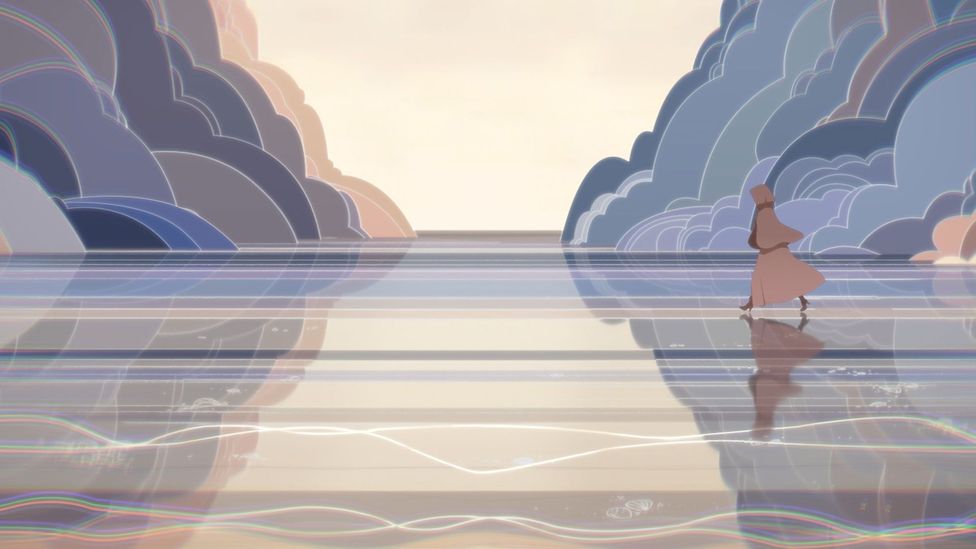
The eclectic team of artists who worked on Belle included Ireland's Cartoon Salon, who brought their beautifully organic drawing style to one key scene (Credit: Studio Chizu)
In contrast to this, Belle's utopian vision of what the internet could be feels radical. U is not just incredible to look at, but it's also a free and borderless public space. In conceiving U, Hosoda and conceptual artist Eric Wong – a London-based architect – came up with a vision of it as a spectacular infinite city with skyscrapers crucially broken up by lots of parks, to emphasise its communality as a space. Wong puts it simply: as the film speaks of togetherness, "the city has to have that language too." It had to feel welcoming. "I remember talking to Eric and we were saying, 'well, if it's really a world made up completely of skyscrapers, no one would really want to live there,'" adds Hosoda.
Indeed, the natural and human-built world, and its geometry, were at the forefront of Wong's mind when imagining U. "Every week we'd always have new references. One of them was Central Park because there were skyscrapers everywhere, but there was a beautiful park down the middle," he says, also noting that U's distinctive twilit sky was inspired by the Manhattan solstice, a beautiful biannual New York event when the setting sun aligns with the Manhattan street grid.
The depth of Belle's vision
What's interesting, too, is that the makeup of Belle's creative team very much supports the internet utopianism of the film, not just because Hosoda discovered Wong online, but because of his generally "borderless" approach to sourcing key artists from around the world. Wong reflects that "that's the beautiful thing about the internet. It could have been anyone in the world [he partnered with]. But he somehow found me." Among the team of artists are Tomm Moore and Ross Stewart from Ireland's Cartoon Saloon, best known for Oscar-winning hit Wolfwalkers, who contributed artwork to a moment where Bell steps outside of the main urban cityscape of U. Paired with Bell's floral costumes, the incorporation of the pair's flattened drawing style, in keeping with the 2D used for the film's vision of the real world and full of organic shapes, further emphasises Belle's conception of the internet as a natural extension of our world, rather than a rival to it.
Meanwhile that sense of joyous diversity underpinning Belle is also reflected in the character designs in the world of U, the peculiarity and variety of which rival even classic Studio Ghibli films like Spirited Away, with a wild host of weird little online avatars. According to Hosoda, "[for] most of them, a number of different designers designed them. And then we would pick the best one". He elaborates that "the reason that I wanted all the designers to be involved in designing the avatars is to get the diversity that you would have in the world of U."
The unifying element of this world and the narrative, Bell herself, is designed by Korean animator Jin Kim, who has shaped the look of many a Disney princess, including Frozen's Anna and Elsa, Bell, like the other avatars in U, reflects a (subtle) element of Suzu's real-world self – as does The Beast, whose hulking, battle-worn appearance mirrors the real world pain of its human counterpart, something that attracts Suzu's concern. But while Hosoda and Kim pay homage to the artists of Disney through Bell's elegance, Hosoda also has some sly fun at the company's expense – the most apparent barb being reimagining Beauty and the Beast's Gastón as Justin, a cop masquerading as a superhero, backed by a slew of corporate sponsors that he projects behind him at every given opportunity, seemingly in mockery of the superhero authoritarians of Disney subsidiary Marvel Studios. He's representative of the less utopian elements of U, an oppressive entity that looms over the otherwise open and gentle space. In this way Belle's portrayal of U, while bright and hopeful, is also not blind to the potential realities, cruelties and consequences of the internet in effectively making the world smaller, and opening its users up to a new kind of scrutiny. As Bell, Suzu is intensely scrutinised and speculated upon, jeered at and idolised, among other things, while the Beast is subject to a witch hunt, steered by Justin.
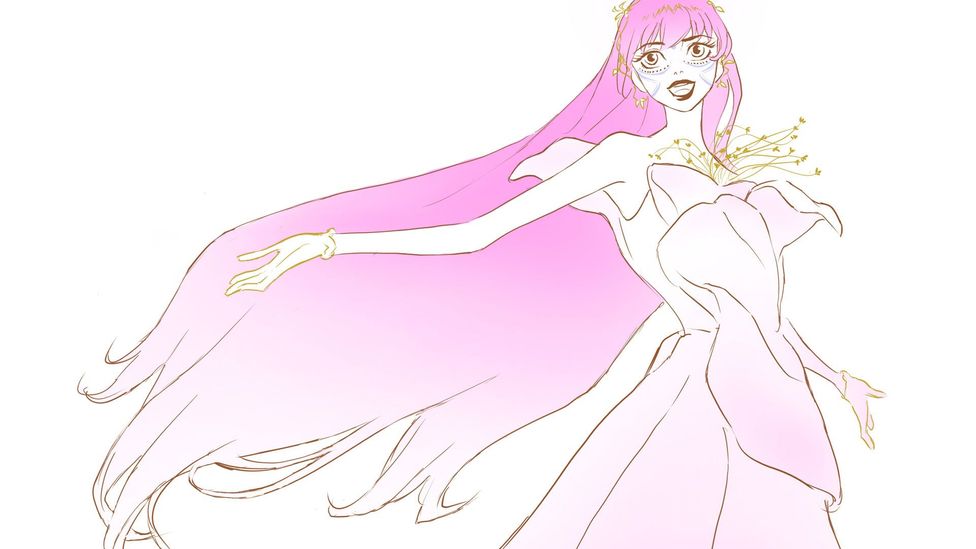
(Credit: Studio Chizu)
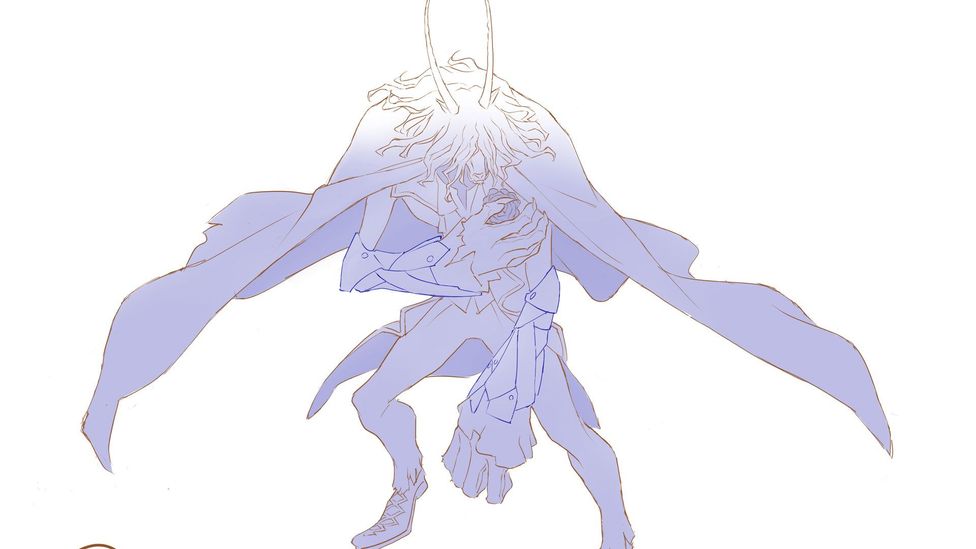
The original character sketches of Bell and the Beast: these avatars are shown to reflect the personalities of their real-world counterparts (Credit: Studio Chizu)
Nor does Hosoda pretend that the internet world of U is a wholesale replacement for the real, physical one. Suzu's performances as Bell take inspiration from her offline existence – and conversely she has to put the learnings from her online persona into action in the real world in order to fully grow as a person, and to help The Beast when no one else will, as she channels the lessons of her departed mother. It's in pondering those real-world benefits of Suzu's online life that U and Belle as a whole become almost transcendently beautiful. Hosoda's vision of the internet is beautiful not just because of the attention to detail in its phenomenal production design but also because of the way that it foregrounds human imagination and human interaction, which is (mostly) resistant to the interference of corporate interest.
Hosoda could be perhaps accused of being naively hopeful, but his thoroughly humanist view of a resource that is continually and cynically commodified is invigorating in its idealism. He dares to suggest that the newfound intimacy that the internet brings to society can actually amplify people's charitable spirit more than it encourages vitriol. It's an idea that can be spotted in the very light source of U – its peculiar, gigantic crescent moon, which both Hosoda and Wong highlight as their favourite visual element of the world because, as Wong says, "it's the light that represents everyone, it belongs to everyone". It's a stirring vision of our digital future – one that we can only hope turns out to be half as compassionate, inclusive and beautiful as Belle imagines.
Belle is released in the US on 14 January and the UK on 4 February
Love film and TV? Join BBC Culture Film and TV Club on Facebook, a community for cinephiles all over the world.
If you would like to comment on this story or anything else you have seen on BBC Culture, head over to our Facebook page or message us on Twitter.
And if you liked this story, sign up for the weekly bbc.com features newsletter, called The Essential List. A handpicked selection of stories from BBC Future, Culture, Worklife and Travel, delivered to your inbox every Friday.
Comments
Post a Comment